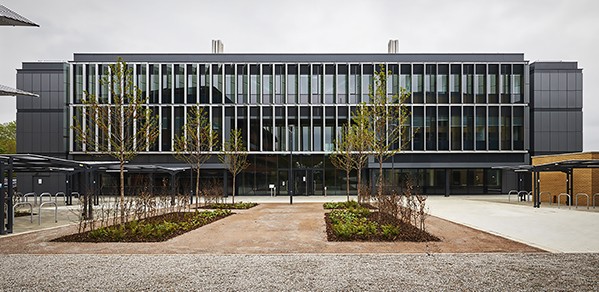
A new multimillion pound collaborative space for the civil engineering industry to work alongside leading researchers from the University of Cambridge will officially open today (24 September).
The opening of NRFIS marks a significant contribution to the UK infrastructure research community which is key to designing, building and maintaining infrastructure that is resilient, adaptable and sustainable.
Professor Lord Robert Mair
Designed to enable University researchers, industry and other academic institutes to work together on joint research programmes, the new Civil Engineering Building, located on the West Cambridge campus, will be officially opened by Andrew Wyllie CBE, President of the Institution of Civil Engineers.
Sustainability and future proofing underpins the design of the building, which houses the new National Research Facility for Infrastructure Sensing (NRFIS) and has 12 world-class, state-of-the-art laboratories focusing on a wide variety of civil engineering disciplines, including sensor development, structures, geomechanics and construction.
NRFIS is part of the UK Collaboratorium for Research in Infrastructure and Cities (UKCRIC) portfolio of research and innovation facilities, funded through the Engineering and Physical Sciences Research Council (EPSRC).
“The opening of NRFIS marks a significant contribution to the UK infrastructure research community which is key to designing, building and maintaining infrastructure that is resilient, adaptable and sustainable,” said Professor Lord Robert Mair, Head of the Cambridge Centre for Smart Infrastructure and Construction (CSIC), which is part of the Department of Engineering’s Civil Engineering division.
“Investment in our infrastructure and infrastructure services, which are so important to citizens, is crucial for the economy and society,” he added. “NRFIS is a facility where academia and industry can engage in protecting and growing the country’s infrastructure base and supporting the UK to be a leader in the field of smart infrastructure.”
NRFIS will support research in the application of advanced sensor technologies to the monitoring of the UK’s existing and future infrastructure, to provide insights and data to inform the design, construction, operation and management of the UK’s infrastructure and enable better decision-making.
It builds on the University’s track record of delivering innovative sensor advancements through CSIC, the CamBridgeSens research network, and the Centres for Doctoral Training in Sensor Technologies for a Healthy and Sustainable Future (STHSF) and Future Infrastructure and Built Environment: Resilience in a Changing World (FIBE2). It also offers an opportunity to explore the development and application of novel sensor systems at a range of scales – from an individual asset, such as a tunnel, building or bridge, to a complex system such as a railway or a city district. More advanced sensors and appropriate data analysis will ensure better asset quality, resilience of enhanced construction safety, and smarter asset management.
The new building also has several innovative features:
- Construction elements that enable the building to be taken apart and re-used including the steel frame which is bolted together rather than welded and concrete ‘planks’ to make the floor
- Extension-friendly adaptable cladding to allow for future expansion of the building
- Thermochromatic glass slates on the facade tint in high temperatures to limit sunlight penetrating the building to maintain best temperature
- Strategically-located sensors delivering real-time feedback on the performance of the building, to include temperature, humidity and carbon dioxide levels.
Professor Simon Guest, Head of Civil Engineering and Professor of Structural Mechanics at the Department of Engineering, said: “We are delighted that our partnership with UKCRIC has given us such fine new facilities to support our research, as it addresses some of the world's most pressing challenges. The building is a great place to work, and a splendid example of how a pleasant building can be designed and built in an environmentally conscious manner.”

